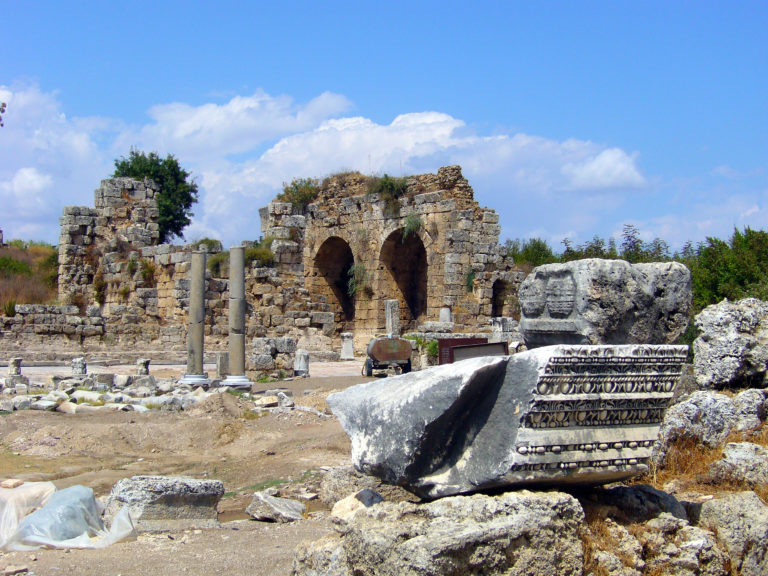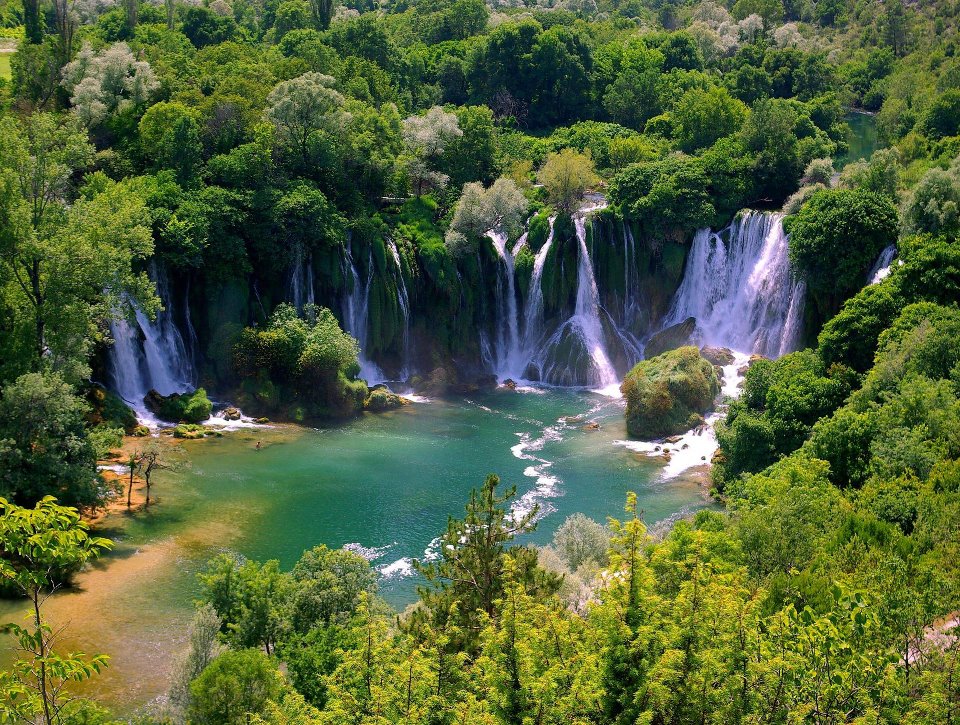Excursions

A dramatic glimpse of a bygone age
The Aspendos Amphitheatre is located just a few kms to the east of Antalya and just North of Belek, it is very easy to get to from any of the hotels in the area. Famous for being possibly the best preserved ancient amphitheatre to be found anywhere in the world, I promise you this place is well worth a visit.
On arrival you can easily be misled by the appearance of the man in Gladiatorial costume standing outside waiting to greet visitors, sword in hand and with a snarling look designed to petrify all onlookers but really intended to encourage you to have your photograph taken at his side. In fact gladiatorial fights wasn’t the original intention when Aspendos was built.
Believed to have been constructed in the 2nd century AD during the reign of the Emperor Marcus Aurelius, this remarkable building can’t help but impress all who take the time to go and look at it and I know this may sound a little strange but this is a building that makes your senses come alive, especially the sense of hearing.
The acoustics are just amazing, which helps explain the origin of the building and why concerts and various staged performances are still held there every year, including ballet, theatre and orchestral recitals. With a seating capacity of over 15,000 people, Aspendos captures a sense of drama and atmosphere seldom found in outdoor theatres, the sound of conversation when no one else is in site, the echo of footsteps carried by the wind along the terraced seating just captures your imagination and yes the thought of Russell Crowe swinging his sword does come to mind.
I could go into great detail about the history of Aspendos but to be honest I suggest you hear it first hand from one of the excellent guides that show you round, their knowledge is far greater than my memory. If history is one of your interests, then to hear about the Trojan War and invasions by the Hittites, Romans and Persians and the arrival of Alexandra the Great will leave you wanting to know more.
There are some wonderful legends about the King of Aspendos and a challenge offering his daughters hand in marriage to the man providing the greatest service to the city, the final two contenders had provided an Aqueduct giving the city a constant water supply and the other designed and built the Amphitheatre, needless to say the decision was made after the King visited and witnessed first hand the drama of the theatre and a little bit of acoustic trickery. Parts of the aforementioned Aqueduct can still be seen towering above the landscape nearby.

A visit to Antalya Harbour is more than site seeing trip out, it’s more like an adventure offering visitors a glimpse of how life used to be over 2000 years ago, you can’t help but fall under the charismatic spell that soon as your imagination running in all directions conjuring up images of Roman Galleys and exotic trading ships.
The city of Antalya is situated high on a cliff surrounding the restored harbour and the picturesque old quarter. The area boasts one of the mildest climates in the country, palm-lined boulevards, lovely parks, many local places of historic interest and an excellent beach all combine to make it a city to suit most visitors.
The old harbour has been completely restored and is the perfect place to while away an evening, dining in one of the many fine restaurants or wandering through the winding streets exploring the many shops and bars.
Walking down the gentle slope to the harbour, you enter a protected historical zone, many fine buildings dating back to the Ottoman Empire have been preserved with their wooden balconies, large doors and courtyard gardens. There are many restaurants, bars and cafes, leather and souvenir shops are a magnet for locals and tourists alike.
The harbour is very picturesque, previously it was the port of Attaleia, founded by Attalus II of Pergamum in the second century B.C. and like most attractive harbours there are the multi million pound yachts and Gin Palaces owned by the rich and famous.
Boat trips are offered to explore the waters that surround Antalya, some lasting just an hour and others for the more adventurous offer fishing or to visit some of the local attractions, these can last half a day.
Some of the best shopping may be found above the harbour in the Kaleici district, not far from the city walls and the historical Hadrian’s Gate. Meander down through the side streets in the old quarter where it is possible to find anything your heart desires, original gold jewelry, leather products, handmade wooden items as well as traditional Turkish handicrafts.
In modern times Antalya Harbour is still set in the hearts of the local people, still a popular place to sit and enjoy the evening air and sip on your favourite beverage in the company of family and friends whilst at the same time enjoying the company of many foreign visitors who flock there in the evening time.
A visit to Antalya Harbour can be arranged from any of the golf hotels in Belek and can be included within your holiday itinerary, if you want to have a special evening out combined with a bit of shopping and maybe dinner overlooking the harbour.

Side (pronounced Ceeday) is a small picturesque harbour town some 35 kms from Belek on the road to Alanya.
Ideal for a leisurely trip out without too much hustle and bustle, although quite small, in its day Side was a thriving town which is easily seen by the many ancient sites to be found there. The Greek amphitheatre was built in the Roman style with massive archways to support the walls due to the fact there wasn’t a hillside to build into being the normal Greek method of construction. For a small entry fee you can enter the amphitheatre and view some of the ancient columns gathered like a giant jigsaw puzzle.
The Temple of Apollo was sited at the far end of the town with magnificent views of the sea and the sunset. Although now in ruins part of the frontal facade can still be seen and is often the site for filming epic movies or Bollywood dance sets.
The town is only about 1200 yards from top to bottom, with a central road full of shops selling all types of wares, golfers often visit Side to buy golf clothing that is a very good copy of the original brand at a fraction of the cost. There are several restaurants and bars to sit and relax and soak up the atmosphere. Side has recently undertaken some major restoration work, which some visitors believe has taken away some of the character but it is still worth a visit.
Kursunlu
Not the biggest of natural parks you will ever visit but certainly one of the most magical, if you are lucky enough to get the chance to visit do not turn it down.
With out any exaggeration this place is just outstandingly beautiful, the waterfalls cascade through the trees forming small rock pools and lagoons which then turn into mini rapids splashing through trees and undergrowth.
The light changes constantly as you walk round, the foliage is verdant as if you were walking through some Amazonian jungle.
The time of year you visit will determine the flow of the waterfalls, during summer months it can be quite subdued, strong shoes are advised, easily walked round in 45 minutes

Perge
Ancient City where St Paul preached the gospel
Situated inland for protection against pirates, Perge is one of the foremost archaeological attractions on Turkey’s southern coast, the Greeks came from central Anatolia around 1000 BC and settled in Perge along with Sillyon, Aspendos and Side to form what became known as Pamphylia, the “land of the tribes”. There is evidence that prior to this was a settlement by the Hittites, the mysterious lost empire that founded Hattusas, who probably founded a settlement 500 years earlier.
According to the Classical author Strabo, the city was founded just after the Trojan War, however, the latest archaeological conclusions suggest that Perge dates back a lot earlier than previously thought, according to Prof. Dr Haluk Abbasoglu Director of excavations at Perge, the site could go as far back as the 5th Millennium BC, with evidence of continual occupation from at least the 3rd Millennium BC.
Part of the attraction of Perge – which is also known as Perga and still pronounced as such – is that it lies on a navigable river, allowing it to function as a port while maintaining a defence against pirate raids. As with all the Greek colonies in Anatolia, the Persians overran the city during the sixth century BC and from 546 to 330 BC, Perge lay under the Achaemenid rule. Yet the inhabitants did not forget their western origins and when the Macedonian Alexander the Great appeared in 330 BC, the citizens sent out guides to lead him to Perge.
After the division of the conqueror’s empire, the city became part of the Seleucids’ domain and it was from around 262 to 190 BC that one of the most famous inhabitants, Apollonius lived. His writings on sections from slicing cones influenced such great thinkers as Descartes and Newton and coined the words ellipse, parabola and hyperbola, nomenclature for certain curves we still use today, his understanding of Geometry is legendry.
It was during later Roman rule that the city also gained notary from visitors who now draw in tourists, Saint Paul, accompanied by Saint Barnabas, preached his first sermon in the city and returned to Perge during his travels. Modern day pilgrims still like to return to the site of the Apostle’s preaching to visit the Basilica.
Although most of the site is now in ruin, Perge offers a rare chance to study ancient civilisations from across the Millennia, be prepared to spend several hours in awesome amazement at some of the achievements made by the inhabitants of this historical treasure.
Take our advise, make the visit with a qualified guide, there is so much to see and equally so much you can miss.
